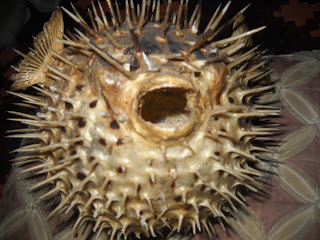Recently, I was given the idea of writing scientific research blog posts--namely biology, geology, or anything else that happens to catch my interest--by a couple people who know me and my odd interests well. Seeing as how this is the career path I've been aiming for once I get out of high school, I've decided to start a new section of my blog, called "Things from the Shelf". The name refers to my bookshelf, which, aside from the inevitable metric ton of books it holds, also serves as a display case for my collection of, well, dead things. For the reader's sake, we'll call them "natural history exhibits".
I tend to collect strange things, like animal skulls, dried starfish, shells, fossilized sea creatures, and anything else you can think of, really. I'll admit I don't actually find most of them myself (at least, not out in the wild). I find most of them at garage sales and thrift stores, weird as that sounds. One of my prize pieces is a dried porcupine fish that I found at a second-hand store.
In my experience, people never seem to appreciate the more interesting things when it comes to thrift stores. They never put prices on the really cool items, and I always end up having to ask around for the cost. This often makes me feel guilty, especially because most thrift stores seem to employ little, white-haired old ladies as cashiers. Whenever I ask how much something is, they tend to go tottering off across the store in search of someone authorized to price the cursed thing, which leaves me feeling guilty and awkward with whatever it is clutched in my hands. When I bought the puffer fish, the lady gave it a long look after I placed it on the counter, squinted in a puzzled manner at me through her glasses, and said to me,
"You actually want that thing?"
She then went tottering off to look for the price.
Puffer fish, from what I've found, seem to be some of the most awkward, bumbling, and at the same time most interesting fish on the planet.
As most people know, their name comes from their tendency to inflate themselves with gulped volumes of water when startled, which swells their highly elastic stomachs and makes them look several times their normal size. Some are equipped with rows of sharp, needle-like spines (I should know, I poke myself on mine whenever I try to clean the shelf) that cover them from head to tail and can be raised to stand on end when they inflate themselves. Most puffer fish are toxic, the result of a peculiar poison secreted by their body known as tetrodotoxin.
Tetrodotoxin, it is surmised, is absorbed by the fish from their food--namely algae, shrimp, and other invertebrates. It works as a neurotoxin, blocking the transfer of nerve impulses along nerve fibers and axons and causing paralysis or even death in its victims. Other sea creatures--like the blue-ringed octopus--are also known to secrete it, and it is known to be 1,200 times more deadly than cyanide. Despite this, puffer fish is served and eaten as a delicacy in some places, particularly Japan. The dish is known as fugu, and requires attention from a very skilled and experienced chef when being prepared. If even one of the deadly poison sacs is not removed from the fish's body before being served, the unfortunate customer is likely to suffer paralysis or even death.
There are over one hundred twenty species of puffer/porcupine fish worldwide. They are from the order Tetraodontiformes (meaning 'four teeth'--referring to the four fused buckteeth that make up their beak-like mouthparts), and are of the family Tetraodontidae (puffers) or Diondontidae (porcupine fish). When they're not inflated, they have a chunky, fat-headed appearance with a tapered tail, and they swim poorly in a manner that reminds me of a half-inflated, lazily drifting balloon. Whey they do inflate, they look like a spiny beach ball, and swimming becomes even harder. In truth, I think the only reason they've survived as a species thus far is because of their inflating adaption.
Now, the main reason I started my posts with my puffer fish is because there's one thing in particular that I've been curious about. The specimen that I have is fully inflated, with its mouth gaping open and the spines sticking out every which way so that it's a real pain to pick up, and I've always wondered how on earth one does taxidermy on a puffer fish. I've always envisioned someone blowing it up like a balloon and tying it off until it has time to dry, and as it turns out, I wasn't too far off.
According to an online taxidermy question and answer site, I found that the best way to mount a puffer fish is to scoop out the meat, leaving the skull behind, and then fill the space with a balloon or Styrofoam mold. When the fish dries, pop the balloon or remove the mold, and pull it all back out through (I'm sorry, readers) the vent. Mine, I noticed, has some stitches along the dorsal side, so whoever mounted it must have used slightly different methods than the advice I read online.
In conclusion, I must say that I've enjoyed researching and writing about this topic. I now know more about puffer fish than I ever have before in my life, and the great mystery as to how to taxidermy one has been solved. Rest assured, I will continue writing short stories and fantasy/sci-fi books and posting them here, but Things from the Shelf is going to become a regular section of the blog. I encourage you to read them, and, if possible, share or comment on the posts.
Happy reading!
S. R. Koch.
Resources:



